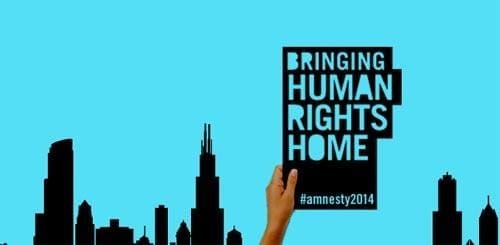Amnesty International's report, Bringing Human Rights Home to Chicago and Illinois, is an action-oriented blueprint for advancing human rights in Chicago and Illinois. The report, prepared in connection with Amnesty International USA's annual Human Rights Conference, outlines ten pressing human rights issues facing the city of Chicago and the state of Illinois as a whole and recommends steps for immediate action by city, state and/or federal officials.
In May of 1972, Anthony Holmes was interrogated by then Police Detective Jon Burge among others at Area 2 Police Headquarters. During his interrogation, Holmes’ hands and legs were shackled while he was forced to sit in a chair. Burge then took the wires from his electric shock box, known by the detectives as the “nigger box” and wrapped the wires around both sets of shackles. Burge then proceeded to repeatedly shock Holmes with the box while suffocating him with a plastic bag, causing him to pass out from the pain. At one point, after Holmes had passed out and fell to the floor, he remembers gaining consciousness while being lifted up off the floor and thinking to himself that he was going to die. He then agreed to falsely confess to a murder he did not commit. The confession, the sole piece of incriminating evidence, was used against him to secure his conviction and subsequent incarceration for thirty years. He has not received any form of compensation.
The accusations are by no means unique. Amnesty International has investigated allegations that detectives in Area 2 and Area 3 police headquarters in Chicago, Illinois, systematically tortured more than 100 suspects between 1972 and 1991. Jon Burge was at the center of these allegations, either directly or through the chain of command. Initially a detective, he held a number of different ranks within Area 2 before becoming the Commander of the Area 2 Violent Crimes Section. Burge later became Commander of the Area 3 Detective Division. Several Area 2 colleagues followed him to Area 3, as did the allegations that they were regularly using torture and other ill-treatment to extract confessions from suspects. In addition to beatings, individuals alleged that they had been subjected to electric shocks, had plastic bags placed over their heads and had been threatened with mock executions. Forced confessions resulted in dozens of individuals being sentenced to long prison sentences or, in the case of eleven individuals, death sentences. All of the victims were of color, with the majority of them African American; the detectives were white. Sixteen victims have since been exonerated and released, according to the People’s Law Office of Chicago, and there are at least 19 individuals who remain incarcerated and allege they were tortured into confessions. The State of Illinois Torture, Inquiry and Relief Commission, an agency set up in 2009 to review the cases of those who claimed to have been tortured by Commander Burge and his subordinates, is still reviewing as many as 71 cases where individuals claim torture by Burge, persons under his supervision at the time or involve officers who had previously been under the supervision of Jon Burge, but were not at the time of the alleged torture. No-one has been prosecuted or convicted for the crime of torture and the vast majority of those tortured have received no compensation for the extensive psychological injuries suffered.
International law strictly prohibits the use of torture and other ill-treatment, and stipulates that governments are responsible for investigating torture allegations, bringing criminal proceedings in torture cases and compensating the victims. The United States has ratified the United Nations Convention against Torture and other Cruel, Inhuman or Degrading Treatment or Punishment (the Convention against Torture) and the International Covenant on Civil and Political Rights, two of the treaties which form the basis of this prohibition.

